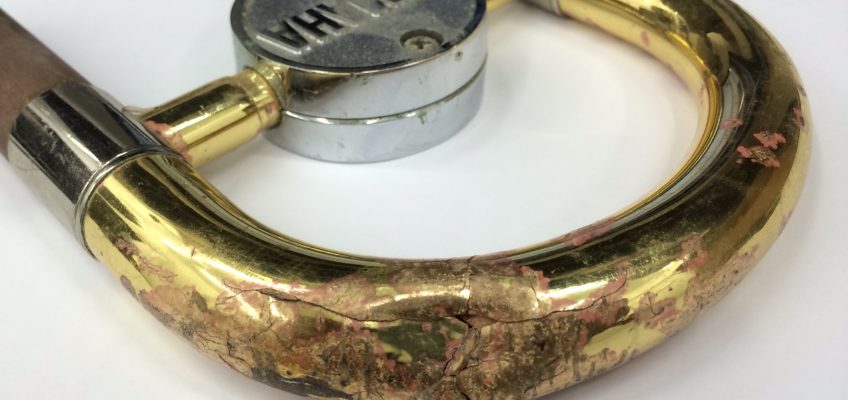Why is chemical cleaning your brass instruments so important?
No one would use a table setting day after day without proper cleaning, yet brass instruments are played continuously without regard for health, sanitary conditions, or the damaging effects on the brass itself and its finish.
Brass is an alloy made up of zinc and copper (typically ~70% zinc, ~30% copper). Brass instruments are especially susceptible to damage from the inside due to a process known as dezincification (or commonly known as “red rot”). Dezincification is caused by organic elements (lime and scale) building up on the inside of the tubing and attacking the zinc in the brass. The organics pull the zinc out of the alloy and leave behind the soft copper. This is commonly found in areas where moisture collects – mouthpipes, crooks of tuning slides, valve casings, etc. It is displayed by small pink spots on the affected area showing through the plating or lacquer. If there are small black spots in the middle of the pink spots, the red rot has eaten through the tubing and it must be replaced.
Here are a few facts about body chemistry, its effects on brass, and chemical cleaning:
- A player’s pH balance will determine the effects their body chemistry will have on the metal
- Acidic saliva / perspiration will have a more profound dezincification effect and will more quickly damage plated surfaces and anything ferrous (screws, rods, steel springs, etc.). It will also attack solder joints and is especially destructive to valves and casings.
- Alkaline saliva / perspiration contains many chemical salts and will result in a white build up (this is lime). It will damage lacquered finishes, form an abrasive coating on pistons, casings and rotors, as well as serve as the main catalyst for dezincification.
- While “washing” a brass instrument regularly with mild soap and lukewarm water is always a good idea, it WILL NOT remove the damaging organics and stop the process of dezincification from inside the instrument! Only heavy acids (hydrochloric, sulfamic, sulfuric, etc.) can accomplish this!
- “Sanitizing” an instrument (i.e. cleaning to remove germs and bacteria) is NOT the same as chemical cleaning. The only way to remove organics and stop dezincification is through chemical cleaning!
- We recommend chemical cleaning once each year. Some players with more balanced pH levels in their body chemistry can go longer (18-24 months) while others who play several hours each day or have a more extreme body chemistry will find they must have their instrument chem-cleaned every 3-6 months.
- Chemical cleaning is about cleaning the INSIDE of the instrument – if you have an instrument that has damaged plating or missing lacquer don’t expect it to come back looking like new after a cleaning – refinishing is a different process!
- A good test to know if you instrument needs cleaning – pull out the slide tubes and look inside them. If you see either a white, chalky coating or a rough, green coating on the tubing – it’s definitely due. The dezincification process has already begun!
Why is chemical cleaning so expensive?!
It’s true – chem-cleaning is an expensive part of owning an instrument! Think about it this way – an instrument is a machine just like the engine in your car and the air conditioner in your house. You wouldn’t dare go several years between oil changes or filter replacement – if you did your car or heat pump would let you know by stranding you on the side of the road or forcing you to sweat out the summer with no A/C!
In the shop there’s a lot to consider when chem-cleaning an instrument. First and foremost we are taking someone’s investment and dunking it in a tub of strong acid! Liability issues aside there’s a lot more to it than that – the time it takes to completely disassemble and de-grease an instrument, go through the chem-flush procedure and reassemble is substantial. Furthermore the costs of the chemicals are enormous (and getting higher every year!). Finally disposal is a significant cost as well – these chemicals must be neutralized and disposed of properly to avoid harm to our environment.
Finally silver instruments must be handled very differently from lacquered horns – the chemical cleaning process takes longer and the instrument must be hand-polished afterward to keep the silver from tarnishing. Keep this in mind when purchasing instruments for your school or for private use – those silver sousaphones may look great on the field however the maintenance costs will be nearly double versus a similar lacquered instrument!

